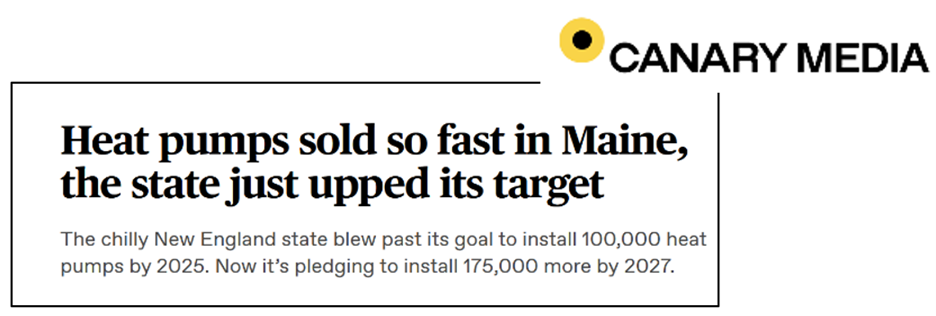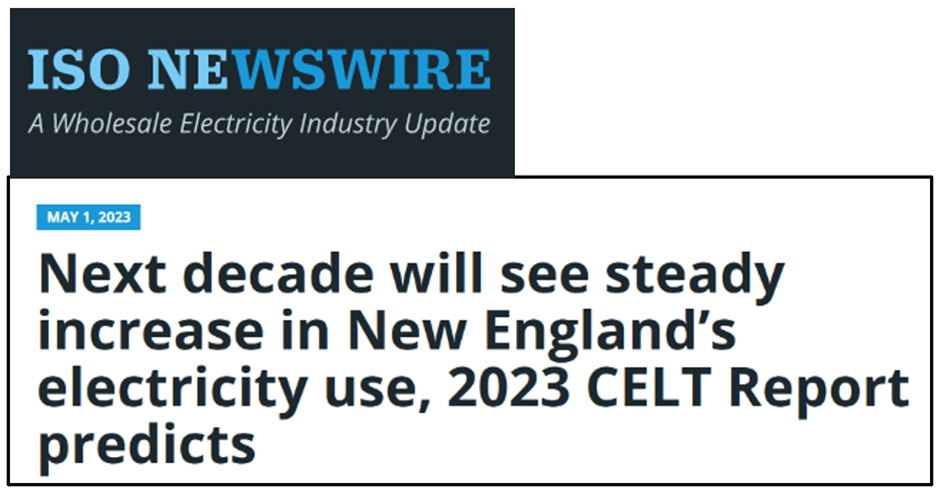New England is a leader in the country in its commitment to a decarbonized economy, with policies to “electrify everything” and support the construction of exponentially more clean energy. The electrification movement is already having a measurable impact on the engineering of the grid and will, over time, embed even more deeply the cost of electricity into virtually every segment of the region’s econom y.
y.
This means that electricity will become even more fundamental not just to businesses, but to families and households.
Leaders in the New England states are coming together to support new types of energy, and they’re also thinking through ways to accelerate the development of an electricity market to support that much-needed generation.
This type of ingenuity isn’t new. The New England states have a demonstrated track record of working together on difficult environmental challenges, and they also worked together on a wide range of economic goals, such as establishing the region’s wholesale electricity markets. These efforts have been thorny, but have yielded true, lasting, durable improvements for the region’s electricity consumers and the environment. As economy-wide electrification expands – particularly in the building and transportation sectors – wholesale electricity market design must evolve in  tandem. To meet the moment, it’s time for the states to take the next logical step and meaningfully price carbon dioxide (CO2) emissions.
tandem. To meet the moment, it’s time for the states to take the next logical step and meaningfully price carbon dioxide (CO2) emissions.
Let’s Talk About the Elephant in the Room
There is no single way to price carbon, and the policy in its many forms has been studied to the point of exhaustion. One recent plan comes from ISO New England, which proposed a “net carbon price.” In this system, the money raised would be rebated back to consumers, with states determining exactly how to use those revenues. NEPGA strongly believes that this program is demonstrably better than the status quo of state-mandated, long-term contracts, which forces consumers to pay higher prices for certain generators and bear the risk if those projects don’t go well.
NEPGA has provided our own extensive analysis to support a multisector decarbonization effort.
The ISO similarly has argued that their proposal would be the most efficient path to meet state decarbonization goals. And we’re not alone: Scores of preeminent economists have pointed to carbon pricing as the best way forward for years.
What Does This Practically Mean?
NEPGA’s report, conducted by the Analysis Group, provided a foundation to guide meaningful CO2 pricing policies by the New England states. At prices between $25-$70/short CO2 ton, the report outlined the way this path would support a dramatic electrification of the economy and meet the aggressive emissions trajectory mandated by the states in the most efficient way possible. The report also explains how the electrification of transportation and heating can lower annual household all-in energy spending by the year 2035 – even before the benefits of lower emissions are taken into account.
It bears mentioning that NEPGA’s analysis was done before Congress passed far-reaching measures such as the Inflation Reduction Act (IRA) and the Infrastructure Investment and Jobs Act (IIJA), which means the benefits that NEPGA anticipated are likely conservative conclusions, not overstated, hopeful, fuzzy math.
For its part, ISO New England’s study, the “Pathways Analysis,” showed that a carbon price met the region’s decarbonization goals with the lowest social costs between 2021 and 2040. In contrast, maintaining current policies was shown to lead to 40% higher social costs by 2040.
Taken for Granted – Existing Clean Energy
Virtually all state policies focus on financing new renewables – the shiny new projects with ribbon cuttings. But these policies ignore the benefits and economic requirements of existing clean energy resources like hydropower, onshore wind, solar, electric storage, and nuclear, to name a few – most of which are reliant on wholesale electricity market revenue to support continued operations. These existing facilities – along with many others – are critical to our energy future.
In 2022, nearly half of the electricity in the region came from low or zero-carbon resources. More specifically, about 17% of the electricity generated in New England came from renewables and about 25% came from nuclear power. Natural gas generation and imports from Canada (whose makeup we can’t verify, but are largely assumed to be large-scale hydropower) supported the remainder of system demand.
 In total, New England is served by one of the cleanest electricity supply portfolios in the country – an enormous foundation on which to build. And build we must as “electrify everything” policies will require New Englanders to use more electricity than they ever have in the past.
In total, New England is served by one of the cleanest electricity supply portfolios in the country – an enormous foundation on which to build. And build we must as “electrify everything” policies will require New Englanders to use more electricity than they ever have in the past.
Driven by electrification, demand on the region’s power grid is expected to increase by about 23% over the next decade. Winter demand for electricity in particular could double by 2050. In Massachusetts alone, utilities are predicting that peak load will double over the same time horizon.
To make all of this work, every serious analysis demonstrates the need to keep the vast majority of the region’s existing electricity resources around to provide a reliable, cost competitive, and cleaner grid.
Unlike long-term contracts and Renewable Portfolio Standards, a carbon price would balance the challenges of supporting both new power sources and existing ones – particularly those that are zero or low-carbon. Even the projects that have state-sponsored contracts now will eventually be left to fend for themselves in the region’s electricity markets. To sustain their operations and recognize the role they play in a heavily decarbonized economy requires action.
Without a meaningful carbon price, wholesale electricity markets will continue to erode due to out-of-market state-sponsored actions. Over time, this threatens the economic viability of existing clean generation and efficient conventional resources necessary to support the long-term transition envisioned by policymakers. That simply doesn’t make any sense. And that doesn’t have to be the case.
The region has a clear choice: continue to subsidize renewable energy through costly, controversial, and inefficient contracts, or pursue widespread deployment by adequately recognizing the environmental value of renewable energy and other non-emitting resources through market-focused enhancements, thereby realizing their benefits in a more competitive and cost-effective way.
Another Elephant in the room: The Existing Fossil Fuel Plants
It may seem counterintuitive, but to deeply decarbonize the electric grid, we need to keep much of the existing fossil-fired generation fleet for an extended period of time – but run them less and less frequently over time. Many studies, including the most recent Integrated Resource Plan (IRP) by the state of Connecticut, reflect this simple reality: Until at least 2050, the New England grid will continue to need much of its existing fossil-fired units as fast-responders amid bad weather, peaking units in times of high demand, and overall contributors to a balanced grid.
 A CO2 price will help optimize the fuels we use to generate electricity and better integrate those fuels into the operations of the complex electric grid. With a meaningful CO2 price, the most efficient resources are dispatched at any given time to meet a given reliability need. This would also incentivize the grid operator to burn fuels like oil and coal only when they are most needed and private investors to put new money into lower-emitting resources.
A CO2 price will help optimize the fuels we use to generate electricity and better integrate those fuels into the operations of the complex electric grid. With a meaningful CO2 price, the most efficient resources are dispatched at any given time to meet a given reliability need. This would also incentivize the grid operator to burn fuels like oil and coal only when they are most needed and private investors to put new money into lower-emitting resources.
This kind of outcome enhances electric reliability — particularly in the winter months — because the market will hold off on using large-scale stored fuel resources for only the most important situations.
New England’s electric grid does not currently work as efficiently as it could. A CO2 price would go a long way in helping close one of the major gaps in the electricity market and drive improved reliability and fuel optimization.
Why now?
The path that New England is on will not meet the challenge of multi-sector decarbonization.
Press reports over the last few years are rife with examples of huge, one-off projects — subsidized by consumers — hitting bumps and delays, or even failing outright. Each time this happens, the solicitation and regulatory processes have to start over, which sets the region  back in building the supply of electricity that “electrify everything” policies require.
back in building the supply of electricity that “electrify everything” policies require.
However, it’s encouraging that states in New England have indicated interest in exploring alternatives to status quo contracting programs.
The most notable public statement came in a report released in May by the Massachusetts Executive Office of Energy and Environmental Affairs (EEA) exploring next steps for clean energy development. The agency concluded that the “use of a regional or multi‐state, market‐based approach to facilitate the development of clean energy generation resources — and, more broadly, to achieve and maintain a clean, reliable, and affordable energy resource mix — could result in lower costs to consumers and would be beneficial for the Commonwealth.”
Let’s Talk about Risk: Who Bears It, Who Should Bear It
We think it’s time to be honest with consumers across New England and change course from the arms race of higher and higher contract mandates (which, increasingly, are not even enabling new project financing and development). Instead, let’s level up to meet the decarbonization challenge and design a flexible, durable electricity market.
 Doing so will put risk back on those most able to manage it – private investors instead of consumers – while lowering emissions, fostering competition, encouraging innovation, and ensuring reliability at the most competitive cost.
Doing so will put risk back on those most able to manage it – private investors instead of consumers – while lowering emissions, fostering competition, encouraging innovation, and ensuring reliability at the most competitive cost.
In its May report, Massachusetts said it was working with other states on this, writing that the state “must collaborate with its regional partners and explore more expedient market‐based approaches to support the development of clean energy, the achievement of state decarbonization requirements, and reduced consumer costs.”
The six New England states have long benefitted from cooperation and have a long history to be proud of. Part of that history is an economic engine with a strong foundation in technology, higher education, and science research, and so it makes sense that the region is the forefront in making climate change a priority. But a priority of this kind demands thoughtful action and evolution away from the status quo.
It is time to put the years of study, deliberation, and consideration into action.
The path forward is a challenging one, but there is an opportunity to chart a course that maintains the benefits of the competitive markets and provide a model for the rest of the country.
This issue has been studied, the results are clear, and the time to act is now.
We’re ready to get to work, so let’s get moving.



